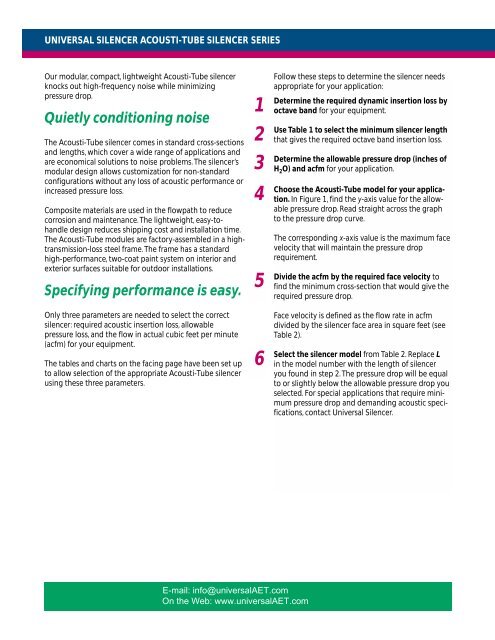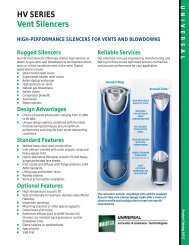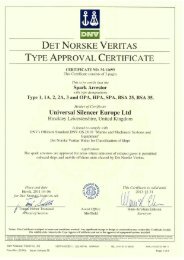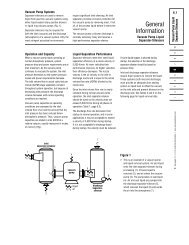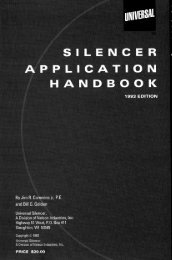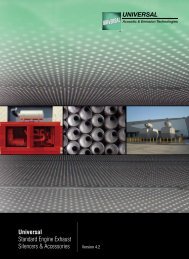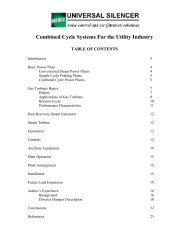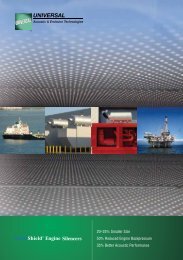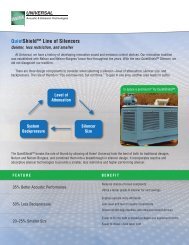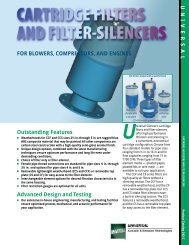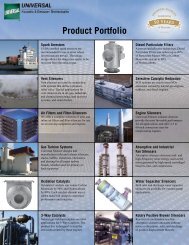Acousti-Tube™ Silencers - Universal: Acoustic Silencers
Acousti-Tube™ Silencers - Universal: Acoustic Silencers
Acousti-Tube™ Silencers - Universal: Acoustic Silencers
Create successful ePaper yourself
Turn your PDF publications into a flip-book with our unique Google optimized e-Paper software.
UNIVERSAL SILENCER ACOUSTI-TUBE SILENCER SERIESOur modular, compact, lightweight <strong>Acousti</strong>-Tube silencerknocks out high-frequency noise while minimizingpressure drop.Quietly conditioning noiseThe <strong>Acousti</strong>-Tube silencer comes in standard cross-sectionsand lengths, which cover a wide range of applications andare economical solutions to noise problems. The silencer’smodular design allows customization for non-standardconfigurations without any loss of acoustic performance orincreased pressure loss.Composite materials are used in the flowpath to reducecorrosion and maintenance. The lightweight, easy-tohandledesign reduces shipping cost and installation time.The <strong>Acousti</strong>-Tube modules are factory-assembled in a hightransmission-losssteel frame. The frame has a standardhigh-performance, two-coat paint system on interior andexterior surfaces suitable for outdoor installations.Specifying performance is easy.Only three parameters are needed to select the correctsilencer: required acoustic insertion loss, allowablepressure loss, and the flow in actual cubic feet per minute(acfm) for your equipment.The tables and charts on the facing page have been set upto allow selection of the appropriate <strong>Acousti</strong>-Tube silencerusing these three parameters.123456Follow these steps to determine the silencer needsappropriate for your application:Determine the required dynamic insertion loss byoctave band for your equipment.Use Table 1 to select the minimum silencer lengththat gives the required octave band insertion loss.Determine the allowable pressure drop (inches ofH 2 O) and acfm for your application.Choose the <strong>Acousti</strong>-Tube model for your application.In Figure 1, find the y-axis value for the allowablepressure drop. Read straight across the graphto the pressure drop curve.The corresponding x-axis value is the maximum facevelocity that will maintain the pressure droprequirement.Divide the acfm by the required face velocity tofind the minimum cross-section that would give therequired pressure drop.Face velocity is defined as the flow rate in acfmdivided by the silencer face area in square feet (seeTable 2).Select the silencer model from Table 2. Replace Lin the model number with the length of silenceryou found in step 2. The pressure drop will be equalto or slightly below the allowable pressure drop youselected. For special applications that require minimumpressure drop and demanding acoustic specifications,contact <strong>Universal</strong> Silencer.E-mail: info@universalAET.comOn the Web: www.universalAET.com


